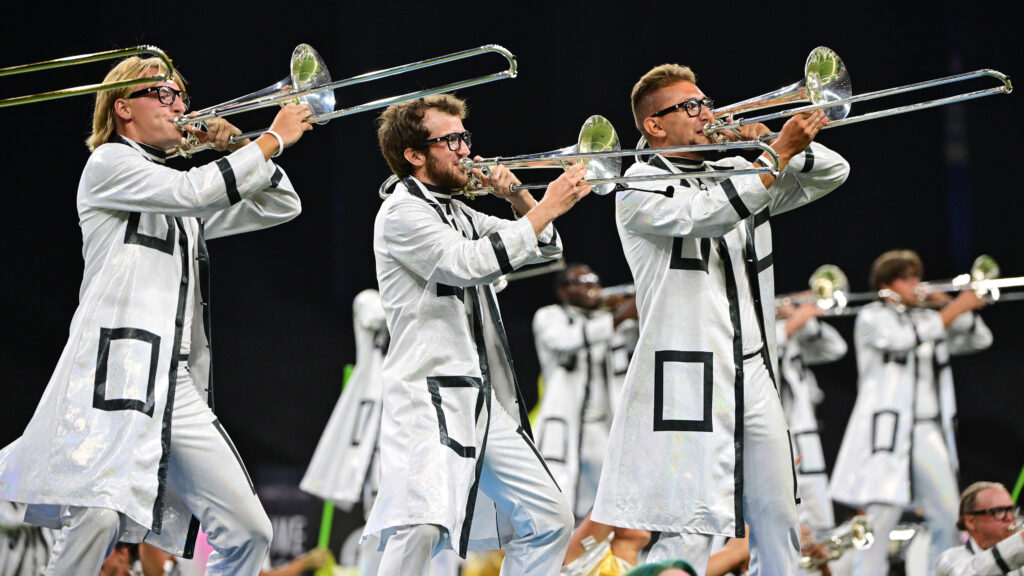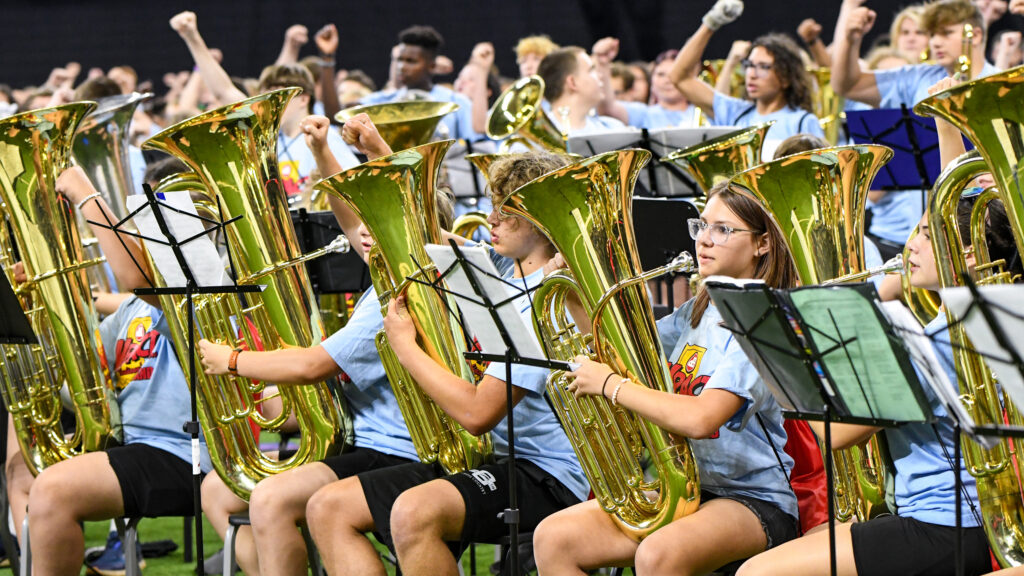Welcome to DCI.org, the Web site of Drum Corps International! If you are one of the multitudes of new fans who enjoyed the broadcast on ESPN2, we thank you for following up and we trust you will have fun exploring our Web site to whet your interests.
On the ESPN2 broadcast, you probably noticed that the modern drum corps is comprised of three elements: Brass, percussion and color guard.
The brass can be bell-front instruments in any key, the higher (smaller) instruments either being trumpets or having much in common with trumpets and the lowest (largest) instruments being tubas or instruments that are similar.
The percussion section is divided into two main components, the battery (marching) instruments and the pit (stationary — usually sitting near or in front of the front sideline).
The battery percussion includes snare drums, multitenor drums, a variety of sizes of bass drums and sometimes a cymbal line, although many cymbal lines have as of late been absorbed into the pit. The pit can include almost anything that can be struck — timpani (usually four or five), a multitude of marimbas, vibraphones, xylophones, bells and chimes (the mallet instruments), a variety of different types of drums, gongs, cymbals, triangles, woodblocks and anything that can make a sound when struck.
The color guard is usually comprised of flags and rifles, but many other devices can also be used that are carried, twirled, tossed, danced with, etc. Once an ensemble of strict military bearing, the guard is now primarily inspired by dance, and often you’ll see a guard engaged in a dance routine without any form of equipment.
Sometimes sets and props are used to help convey a storyline. This past year, such items included a large door, ladders, umbrellas, cots, and a large variety of items that were either handheld or sat on the field and served as a visual focus.
All members of a corps except the members of the pit find themselves marching around the field for most of the show, often at accelerated tempos that can tax the bodies of one who isn’t conditioned for such activity. Due to this elevated demand for physical conditioning, corps have programs during the winter and spring to help their members get and stay in shape. Studies have shown that corps members marching their competition show can physically put out as much effort as a football player running down the field or a basketball player scurrying around the court.
Drum Corps International is the governing body for the junior drum corps movement in North America. Members can be up to 22 years old. Think of DCI as you might think of the NCAA, but for youth pageantry instead of conventional sports.
Corps start auditioning for new members usually around Thanksgiving and start working on next year’s shows almost immediately thereafter. Intense rehearsal “camps” throughout the winter and early spring help the corps develop their shows into the polished products seen on the ESPN2 broadcast. As the summer season gets closer, rehearsals become more numerous. As the marchers move in after school is out, the corps then go into a mode that requires a solid summerlong commitment to excellence.
Many corps travel the country much of the summer. The corps in Division I competition meet several times throughout the summer at locations around the country. The corps in Division II & III often have somewhat less strenuous tours and tend to skew to a younger average age throughout the individual corps, but the quality is still first-rate.
We hope you enjoy visiting DCI.org, and we hope to either see you in the stands in 2006 as a fan or even in a corps as a marcher or volunteer helper. Drum corps is a great activity, a wonderful way to spend a summer, a superb way to make friends and a magnificent avenue for creative expression.
Thank you for your interest and please ask questions if we can be of further assistance in directing you towards a corps in your region. Also, be sure to visit our online store for DVDs and CDs of our World Championships from past years, plus a number of other souvenir items.





